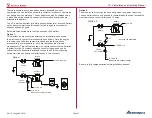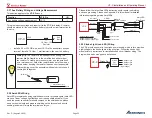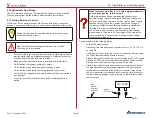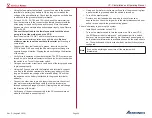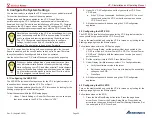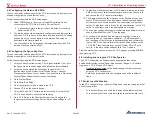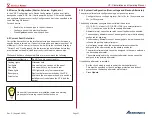
Page 65
VP-X Installation and Operating Manual
Rev. D (August 5, 2020)
9.
Troubleshooting
Follow these instructions for each system.
Please contact Vertical Power Support at 425.328.1658 if you have any
questions.
9.1
Flap Configuration
Verify correct flap operation by following these steps, IN ORDER:
1.
Connect the VP-X Configurator and select the flaps section.
2.
Enable the flaps and press ‘Update’ button.
3.
Set the flaps to ‘Momentary’ and press ‘Update’ button.
4.
Verify that the ‘Faulted’ field (under flap status) is No.
5.
Move the flaps using the up and down buttons on the Configurator.
If the flaps move in the opposite direction, then change the motor
polarity setting and press ‘Update’ button.
6.
Move the flaps using the flap switch installed in your aircraft. If the
flaps move backwards, then the flap switch inputs are reversed.
7. If a POS-12 is installed, verify the number next to the ‘Position:’ label
(under flap status section) changes as you move the flaps. This
number could range between about 0 and 255 as move the flaps
through their FULL travel range.
8. If the position value does not change, then the position sensor wiring
is incorrect.
9. The number SHOULD ACTUALLY span a smaller range of 20 to 240
or so. If it goes all the way to either 0 or 255 then the sensor has
hit its limit and you won’t get an accurate reading at the endpoints,
which is important. Change the mechanical linkage so that the
sensor does not hit its limits.
10.
Run the flaps up and record the top position reading on paper. This is
a number between 0 and 255.
11.
Run the flaps to each intermediate stop (if any) and record the
position reading(s) on paper.
12.
Run the flaps to the bottom position and record the bottom position
reading on paper.
13.
If you have the flap system in ‘Momentary’ the position values are
used only to display the flap position on the EFIS. However, if you
want to use the ‘Position’ mode, then the position values are used to
stop the flap motor at the top, middle, and bottom positions.
14. In some instances the top position may be near the 0 value, or it
may be near the 255 value. It just depends on how the mechanical
linkage is designed. Either way is fine. The bottom position should be
on the opposite end of the 0-255 range from the top position.
15. The position sensor combined with the mechanical linkage has
some slop in it. To account for this slop, the VP-X can run the flap
motor slightly longer than needed so that the flaps are fully retracted.
To accomplish this, set the ‘End Duration” to 0.5. This will run the
flaps for an extra half second at both the top and bottom limits, when
in position mode.
16.
Set the top, bottom, and midpoint values in the configurator. We will
use an example here, but your values may be on the opposite end
of the scale. If the top value you recorded above is 10, then set the
value to 20. The end duration should run it up to 10, as it will run for
one half second past when it reaches 20. You can then adjust the
numbers as necessary.
17. Enter the mid-point values exactly as you recorded them above.
18. The bottom value is the trickiest to set correctly because the loading
on the flaps is different in the air than on the ground, so the down
value may be different in each case.
19. If the recorded down value is, for example, 240 on the ground, it
might be 235 in the air because the air loads on the flaps do not
allow the flaps to fully extend as they do on the ground. To solve this
using this example, set the down value to 230. The system will then
run the flaps for half a second after it reaches 230. If the down value
were to be set at 240, the position sensor may never report 240 and
only get to 235 which causes the flap motor run-on protection to trip
the flaps after running for 45 seconds.
20.
For the first few flights we recommend running the flap system in
‘Momentary’ mode. After you are comfortable with the airplane, then
set it to ‘Position’ if so desired.
21.
Set the flap system to ‘Position’ and press ‘Update’ button.

